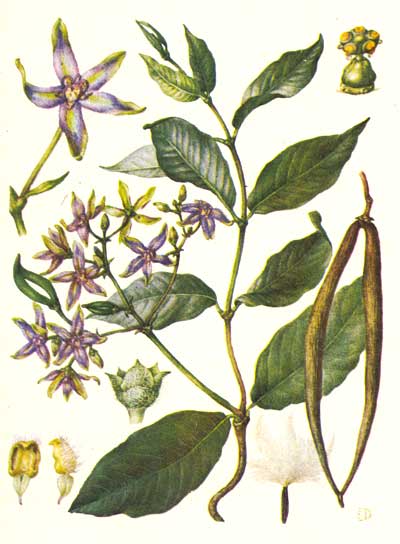Obvanik Greek – Periploca graesca L.
Family Asclepiadaceae – Lastovnevye
Greek obvoynik - description of the plant
climbing plant. Length of stems reaching up to 12-15 m height, with red-brown bark, sometimes Brown or grey-brown, Beech, green young shoots. Leaves are opposite, from ovate-lanceolate to elliptical shape 6-10/13 cm in length and 3-8 cm in width, darker green on top, bright, gray-green below. Inflorescences are located on the tops of branches or on their sides, forming half umbrellas. Separate cup. Disc-shaped corolla, deeply five-petalled, oblong petals, dark purple brown above, omitted. Fruit cylindrical leaflet. Numerous flat seeds, with a long silky crest. Blooms in May - July.
Spread. Grows mainly in damp valley forests, bushes and along the seashores. Distributed along the Black Sea coast. Also found in southeastern Europe.
Raw materials. Roots or young branches, collected in early spring from the stems of climbing bushes.

Content of active substances in Greek obvoynik
The bark and young branches of the plant contain the cardiac glycosides periplocin and periplocymarin. Periplocine (C36H56O13) splits into periplogenin and periplobiosis (D-cymarosa + glucose). Periplogenin is a derivative of cyclopentaneperhydrophenanthrene, similar to strophanthin, with that difference, what's in place C10 Instead of an aldehyde group there is a methyl group.
Periplocimarin (C36H46O8) splits into periplogenin and D-cymarose.
The leaves of the plant contain a small amount of periplocin., 0,72% rubber, chlorogenic, isochlorogenic, coumaric and ferullic acids, rutin, izokvercitin, esculin.
The main medicinal effect of Greek obvoynik
Enhances cardiac activity.
Experimental and clinical data on the therapeutic effect of Greek birch
The cardiotonic activity of the plant is definitely associated with the presence of the glycoside periplocin in it., first isolated and proposed by Russian researchers E. Leman and R. Berginsky in 1896 year. Periplocin belongs to the group of cardioactive glycosides, since in its functional characteristics it is close to the activity of strophanthin. Periplocin, discovered at the end of the century before last, was soon forgotten due to the impossibility of isolating it in its pure form.. Interest in him was awakened again in 1936 year, when Murdzhiri and Kutateladze managed to obtain it in its pure form, and pharmacologists of school M. P. Nikolaev - to study its pharmacological properties. As a result of these studies, as well as a number of later tests, It was found, that periplocin has a positive inotropic and negative chronotropic effect on the heart muscle. Under its influence, an undoubted diuretic effect was observed. A detailed study of it made it possible to characterize periplocin as a cardioactive glycoside, similar in action to strophanthin. This defines the proposition M. P. Nikolaev to use it as a substitute for imported strophanthin. Chistyakova-Pokrovskaya (1940) in his PhD thesis “The cardiotonic activity of periplocin proves, that the alcohol infusion from the bark of the conjugator is similar in effect to the strophanthin infusion.
The main indication for the clinical use of periplocin is chronic heart failure of degrees II and III.. Saturation of the body with glycoside leads to weakening and complete cessation of shortness of breath, palpitations and cyanosis. Such beneficial effects of periplocin occur already on the second day from the start of its use (fast onset effect). On the 8-10th day after the start of treatment, complete disappearance of edema and normalization of pulse deficit are observed..
Periplocin for blood pressure, like other cardioactive glycosides, have an amortal effect, t. it is. Then, when it is increased, a decrease occurs under the influence of the drug, and when it is lowered, the pressure normalizes.
In experiments for biological standardization it was established, that the cardiotonic activity of periplocin is 3-4 times lower, than that of strophanthin glycosides, with the same toxicity.
Greek obvoynik is a highly poisonous plant.. Even in ancient times, even to this day, wild tribes in Africa smear the tops of arrows with it to hunt wild animals.
Periplocin is also used as a starting material for the production of steroid hormones. The stems of the plant contain shiny long bast fibers, that can be spun.
The use of Greek obvoynik in folk medicine
In folk medicine, it is recommended to use oboynik for kidney diseases., which can be associated with the pronounced diuretic effect of the plant.
Undesirable effects of using Greek obvoynik
Periplocin is a highly toxic compound, and its use even in small doses, may cause toxic effects, therefore you need to be careful when using it. It can only be used for treatment under the direct supervision of a physician..
Method of using Greek obvoynik
An infusion of 40° alcohol is prepared from the bark of the birch tree..
